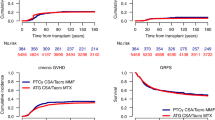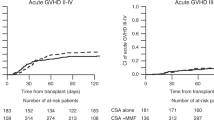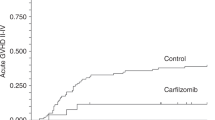Abstract
The tolerability, anti-tumour activity and pharmacokinetic interaction of high-dose intravenous cyclosporin combined with intravenous etoposide was evaluated in children. Eighteen patients with recurrent or refractory tumours, all of whom had previously received etoposide, were treated with a combination of high-dose cyclosporin and etoposide. In 13, cyclosporin was given as a continuous infusion (15 mg kg(-1) per 24 h for 60 h) and in five a short 3-hour infusion of 30 mg kg(-1) day(-1) on three consecutive days. Pharmacokinetic profiles of etoposide were determined with and without cyclosporin. Cyclosporin levels ranged from 1359 to 4835 ng ml(-1) and cyclosporin increased the median area under the concentration time for etoposide curve from 7.2 to 12.5 mg ml(-1) min. The major toxicity was acute with varying forms of hypersensitivity reactions. In four cases this was severe. Hyperbilirubinaemia was present in 25 of 32 courses but was of short duration. In 14 courses, creatinine and/or urea was elevated, but was also transient. Significant hypertension was seen in six courses. Four of 17 patients evaluable for response obtained a partial response and one showed stable disease. It is concluded that in children given the combination of high-dose cyclosporin and etoposide, the etoposide dose should be halved in order to achieve an area under the drug concentration-time curve similar to that with etoposide alone. A continuous infusion schedule of cyclosporin is better tolerated during the period of administration but is associated with similar hepatic and renal dysfunction to a short schedule. The 24% response rate in children who had previously received etoposide suggests that this may be an effective method of enhancing drug sensitivity and further phase II evaluation is justified.
This is a preview of subscription content, access via your institution
Access options
Subscribe to this journal
Receive 24 print issues and online access
$259.00 per year
only $10.79 per issue
Buy this article
- Purchase on Springer Link
- Instant access to full article PDF
Prices may be subject to local taxes which are calculated during checkout
Similar content being viewed by others
Author information
Authors and Affiliations
Rights and permissions
About this article
Cite this article
Bisogno, G., Cowie, F., Boddy, A. et al. High-dose cyclosporin with etoposide - toxicity and pharmacokinetic interaction in children with solid tumours. Br J Cancer 77, 2304–2309 (1998). https://doi.org/10.1038/bjc.1998.383
Issue Date:
DOI: https://doi.org/10.1038/bjc.1998.383
This article is cited by
-
Prediction of Clearance in Children from Adults Following Drug–Drug Interaction Studies: Application of Age-Dependent Exponent Model
Drugs in R&D (2020)
-
Database of adverse events associated with drugs and drug combinations
Scientific Reports (2019)
-
Interactions Between Inflammatory Bowel Disease Drugs and Chemotherapy
Current Treatment Options in Gastroenterology (2016)
-
Effects of cyclosporine A on the hepatobiliary disposition and hepatic uptake of etoposide in an isolated perfused rat liver model
Cancer Chemotherapy and Pharmacology (2015)
-
Pharmacokinetic interactions of cyclosporine with etoposide and mitoxantrone in children with acute myeloid leukemia
Leukemia (2002)



